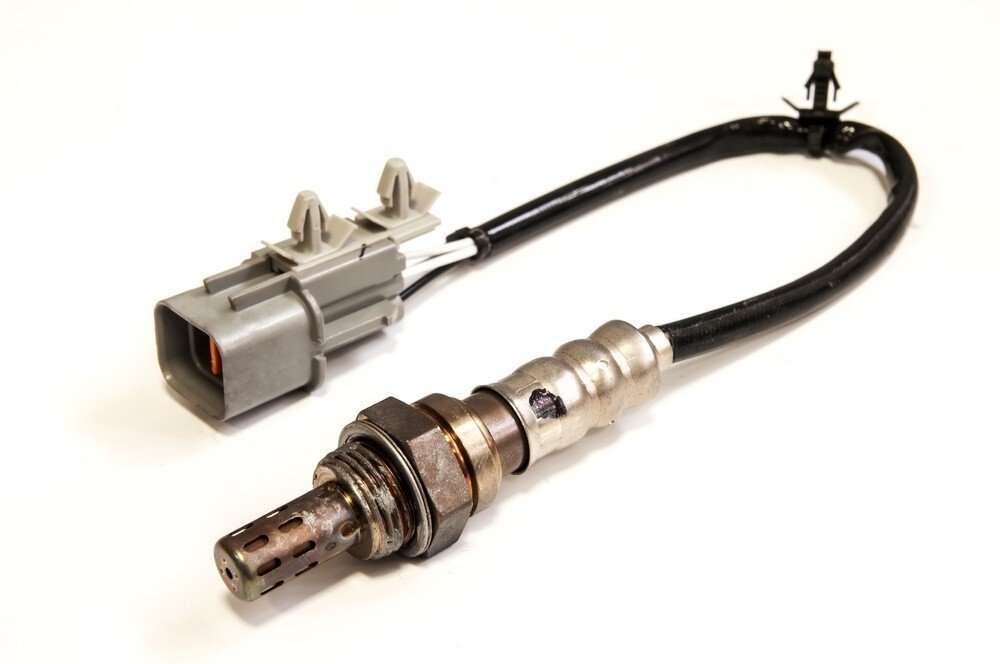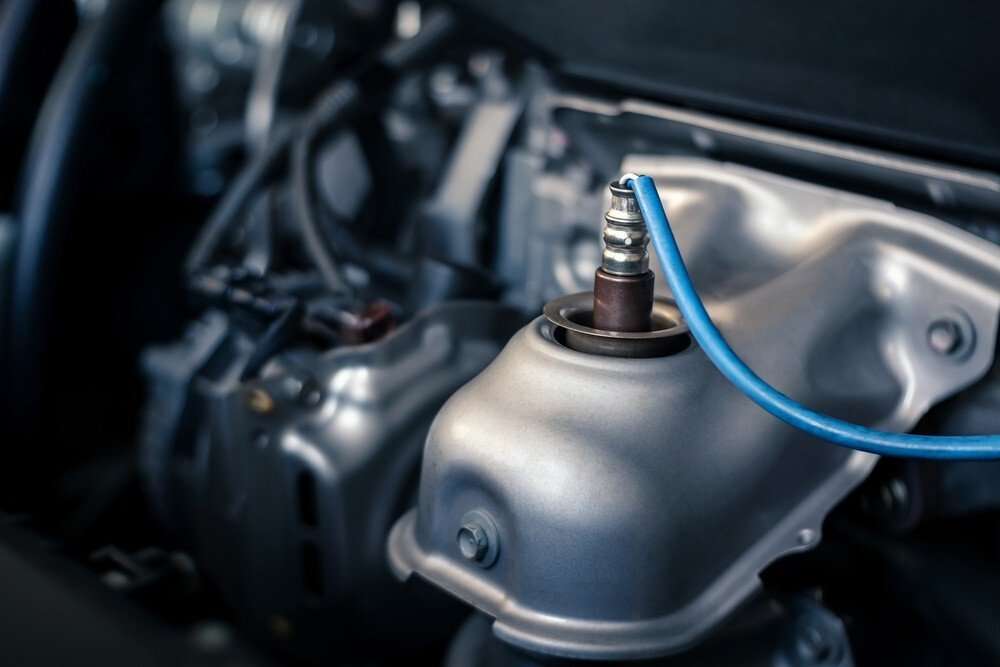The oxygen sensor is one of the most vital parts of your vehicle. It’s located in the exhaust manifold, attached directly to the engine block, just before the catalytic converter. It measures the amount of oxygen in the car’s exhaust and reports this information back to your car’s computer.
The results are used to adjust several different systems on a modern vehicle, including fuel delivery, air/fuel mixture, and ignition timing. If any one of these systems becomes out of balance, things can go bad quickly.
An O2 sensor is a monitoring device that tracks the amount of oxygen in your engine’s exhaust. It ensures that the right amount of oxygen is getting mixed properly with fuel and air.
If your car isn’t getting enough oxygen or too much, it’ll result in affecting the engine’s performance and lifespan. It can lead to premature wear and tear on various parts. Therefore, it’s important to know if you have a bad O2 sensor, and this article will help you with that!
Jump to
Importance of Oxygen Sensor in a vehicle
Here’s a list of the main benefits of vehicle Oxygen sensors:
- Help your car provide you with better fuel economy.
- It can help to increase the performance of the engine. The feedback from the oxygen sensor makes the air-fuel ratio optimal which results in better performance of the car.
- A bad oxygen sensor can significantly decrease the fuel economy of your vehicle. Replacing a faulty oxygen sensor will restore your vehicle’s fuel consumption.
- The oxygen sensor can prevent harmful emissions from being released into the environment.
- The oxygen sensor detects when something has gone wrong with the fuel mixture in the engine and tells you if there is too much or too little fuel being used.
- It also stops the car from overheating.
- An oxygen sensor is important for increasing the performance of the car.
10 Common Symptoms of a Bad Oxygen Sensor
Nowadays, cars are more than just a means of transportation. They’re the way we share in activities like commuting to work or school, running errands with friends, and hitting the open road for our yearly vacation.
While your car is an important part of your life, it also takes a toll on you. It deteriorates with time due to normal wear and tear and exposes you to dangerous emissions as well. One way you can take better care of yourself and your vehicle is by making sure it has clean air inside as well as outside!
That’s where an oxygen sensor comes into place. It detects when something has gone wrong with the fuel mixture in the engine so that you know if there’s too much or too little fuel being used. It also helps you maintain your car’s peak performance and keep it running safely all the time.
If you have a bad oxygen sensor, there may be symptoms that indicate this fault. Here are some of the most common signs:
1. Poor Fuel Economy

If your car is struggling to maintain its usual pace, or you’re noticing that it needs a lot more gas than usual, it may be because of a bad oxygen sensor. Oxygen sensors make sure the air/fuel mixture has the right ratio for combustion in the cylinders.
If it becomes faulty, it’ll allow the engine to inject less or more fuel than needed. It can lead to several problems, including poor fuel economy. In such a case, you’ll need to replace the faulty oxygen sensor to increase your vehicle’s fuel mileage.
2. Hesitation at Low Speeds
If your car starts acting sluggish after you come to a stop or slow down, this could mean that your car’s oxygen sensor isn’t working correctly.
A properly working oxygen sensor shuts off when you slow down or stop so that it doesn’t produce incorrect readings since there’s less air moving through the exhaust system.
But if it becomes faulty and isn’t shutting off when it should be, then your engine may not run at its highest efficiency, to say the least.
3. Lack of Power

If you have a powerful car but you feel that it has recently started lacking power, especially while accelerating, it may be that your oxygen sensor is to blame.
As a result of a bad O2 sensor, your vehicle can have an incorrect air-to-fuel ratio and it can cause your engine to work harder than usual.
4. Check Engine Light

The O2 sensor of your vehicle has a powerful influence on the combustion process of the air/fuel mixture. If there’s less oxygen present in exhaust gasses right after the combustion process, the oxygen sensor will inform the engine control module to correct it.
However, if your O2 sensor isn’t working correctly, the engine control module can fail to correct the problem mentioned above. As a result, you’ll end up with weak engine performance and the engine control module will turn on the check engine light.
There are multiple reasons why the check engine light turns on. For example, it can be due to a faulty oxygen sensor, problematic catalytic converter, flawed gas cap, and so on. It makes it very difficult to understand the real issue.
5. Excessive Exhaust Smoke
If you notice that there’s more exhaust smoke coming out of your tailpipe than usual, then it may be a result of a bad oxygen sensor.
When your sensor malfunctions, it can cause the fuel mixture to be too rich or too lean, which will make you have a lot more exhaust smoke than usual.
6. OBD Warning Light
An oxygen sensor is a part of your vehicle’s on-board diagnostics system. If the OBD warning light comes on and you see the check engine alert, there’s something wrong with the sensor. In such a case, you’ll need to get your vehicle checked as soon as possible.
An oxygen sensor tells your engine computer how well the fuel mixture is burning in each cylinder. So, if there is a problem with this reading then the OBD will alert you.
7. Excessive Oil Consumption
If your car needs more oil than usual, then this may be because of a problem with your oxygen sensor. If it malfunctions and throws off the fuel mixture in your engine, you might notice that you need to add more oil than usual into your engine.
Plus, an oxygen sensor can cause extra wear in other parts, such as belts and hoses, of the car as well. If you’re noticing excessive oil consumption, get your car checked by a professional mechanic.
8. Corroded Wires
If you notice that the wiring in your engine is corroding and there are small amounts of corrosion on some of the wires, this is usually due to an oxygen sensor malfunctioning.
A faulty O2 sensor can allow unburnt fuel to enter the exhaust system and some of it can end up corroding your wires. Therefore, if you notice corrosion like this, it may be because you have a faulty oxygen sensor.
9. Rotten Egg Smell

If you notice that your car smells like it’s burning all the time, this is usually because of a flawed oxygen sensor. A malfunctioning oxygen sensor can cause your car to run rich, which will result in an offensive smell similar to rotten eggs.
10. Rough Idling Engine
When you stop or park your vehicle and feel that your engine doesn’t run steady, then there’s a rough idling problem. For example, if the normal RPM rate of your vehicle’s idle engine is below 1,000 but the engine is reaching 2,000 or even 3,000 RPM, then you might have a faulty O2 sensor.
In this scenario, your engine control module will find it difficult to control the engine timing. As a result, your vehicle will have combustion intervals causing misfires.
How To Diagnose a Bad Oxygen Sensor?
Many people don’t realize that oxygen sensors are an integral part of the exhaust emission system. Your car can run perfectly fine without a functioning oxygen sensor, but you’ll notice a difference in the driving experience, fuel economy, and engine behavior.
When oxygen sensors malfunction, they often don’t have any noticeable symptoms at the start. Therefore, many people ask “What does a car do when the oxygen sensor is bad?”
The symptoms of an oxygen sensor malfunction mentioned above will help you check if your car is experiencing any problems related to the O2 sensor.
But what you need to do is determine whether or not the oxygen sensor needs to be replaced. If you don’t replace the oxygen sensor, it can lead to other problems.
If the oxygen sensor is experiencing any problems, then it will usually affect your engine’s performance in one way or another. So, consider taking your vehicle to a licensed and experienced mechanic to get the oxygen sensor checked.
How to Test a Bad O2 Sensor?

If you’re wondering “How do I test oxygen sensors in a car?”, here are some easy ways to check if your oxygen sensor is bad.
Check for Codes
If you’re not sure whether or not your oxygen sensor is causing issues with the performance of your car, you can check the computer for codes.
This is one of the best ways to find out if your car’s oxygen sensor has anything wrong with it. Some common DTCs (Diagnostic Trouble Codes) that are related to O2 sensor problems include P2270, P2195, P0172, P0161, P0141, P0140, P0137, P0134, P0133, P0132, P0131, P0130, P0031, and P0030.
Check for Engine Misfires
Listening carefully to your car’s exhaust is one of the easiest ways to check if your oxygen sensor is faulty. If you’re hearing any sort of abnormal sound, this could mean that your oxygen sensor isn’t working properly.
Order A Diagnostics Test
You need to take your car to an auto store and have them run diagnostics on the oxygen sensor. The auto store will determine whether or not your oxygen sensor needs to be replaced and they’ll also inform you about the cost of replacement.
If it turns out that you need to have your oxygen sensor replaced, then you can schedule an appointment with a mechanic.
Can You Drive a Car with a Bad O2 Sensor?
Even though there are some common symptoms of an oxygen sensor malfunction, you can still drive your car with a bad one if the symptoms don’t affect the safety of your vehicle or its performance.
But if you’re experiencing any problems with the main operation of your car, it’s highly recommended that you get the oxygen sensor checked out by a certified mechanic as soon as possible.
What Happens If the Oxygen Sensor Is Not Replaced?
If you don’t get your oxygen sensor replaced as soon as possible, this will lead to other problems. The catalytic converter won’t perform its function well, which will cause the oxygen sensor readings not to provide accurate information.
You’ll have problems with the performance of the vehicle, and you’ll pay more for maintenance and repairs. Additionally, your vehicle can also start consuming too much fuel, costing you a whole lot of money.
Final Thoughts!
A bad oxygen sensor can lead to serious damage to your car’s engine if it isn’t caught and fixed timely. If you take the time to familiarize yourself with the symptoms of a bad oxygen sensor, you can save yourself a lot of money in repairs down the road.
With this handy guide, you should now be able to diagnose and replace a bad oxygen sensor in your vehicle. We hope this guide has helped you learn more about oxygen sensors and how they affect your vehicle.

My name is Tom Harris, founder of this blog. I’m a mechanical engineer with 20 years of experience in the automotive industry. I’m here to help you with your vehicle’s problems, easy fixes and share my insights and experience so that you can enjoy your rides more.


I have a 1988 Dodge B250 van with a 318 engine. I noticed loss of power on large hills and like a misfire or shake when driving but not all the time. I have changed fuel filter, fuel pump and strainer. I have changed plugs.wires,distributor cap and rotor and coil no change. I have no check engine light if there is one on this old of vehicle. I have asked shops and they just say it could be what i have done so far. I was wondering it it could be oxygen sensor. thanks